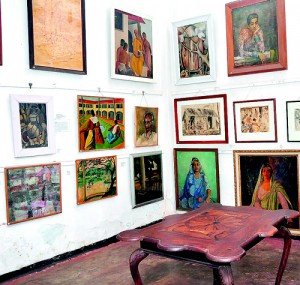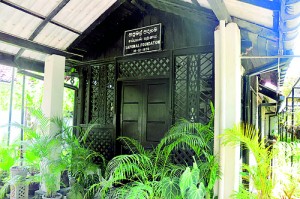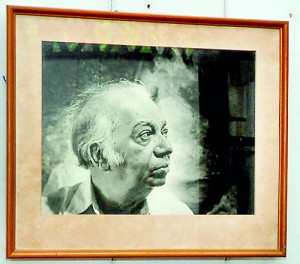A houseful of art
I’m wary of sweeping, absolute statements but here’s one that I can unhesitatingly stand by: The Sapumal Foundation is a must for art lovers.
The first impression is that of accidentally wandering into someone’s house–but a house crammed with some of Sri Lanka’s best known art names. And that is perhaps exactly what it is, delightfully devoid of any pretension or grandeur. In the living room, some of the  greats of the Sri Lankan art world adorn its walls and gently jostle each other to catch your eye. Ivan Peries’ large canvas ‘Bathers’ takes visual dominance over the space, while George Keyt’s ‘Man on Elephant’ vies for your attention with its bold ochre and tones of green.From across the room amidst other paintings, Justin Daraniyagala’s ‘Woman and Bull’ beckons with its textural sensuousness.
greats of the Sri Lankan art world adorn its walls and gently jostle each other to catch your eye. Ivan Peries’ large canvas ‘Bathers’ takes visual dominance over the space, while George Keyt’s ‘Man on Elephant’ vies for your attention with its bold ochre and tones of green.From across the room amidst other paintings, Justin Daraniyagala’s ‘Woman and Bull’ beckons with its textural sensuousness.
The Galleries of the Sapumal Foundation lack the archetype features of a modern art galleryand instead contains all the elements of a coming of age story: the narrative of a boy interested in art, his development as a painter and teacher, his role in spearheading a fellowship of modern artists and his desire to share the inheritance and advantages he received.
To better understand the Sapumal Foundation, one needs to understand its founder, Harry Pieris. Harry was inspired by Ananda Coomaraswamy’s ideal that, “Nations are made by artists and poets, not by traders and politicians. Art contains in itself the deepest principles of life, the truest guide to the greatest art, the art of living” and his life laid testament to this. Harry Pieris studied at the Atelier School of Art in Colombo and then went on to the Royal College of Art where his portrait of his uncle, Sir James Pieris won the best portrait award for that year.
After a brief stint back in Colombo, he worked and studied in Paris for six years and then worked in Shanthi Niketan, India for two years.Matisse and Henri Cartier-Bresson were among the many friends he made during his time abroad and his years in Paris and India

The entrance and right, great works side by side. Pix by Mangala Weerasekera
greatly influenced his art. Believing that good art was a love affair between the artist and his work, he worked towards the promotion of the arts and was committed to being a teacher. Upon his death, the house was discovered to be teeming with a profusion of artwork – from pencil sketches stuffed in drawers and crevices to canvases rolled and stored in corners.
After the death of Lionel Wendt in 1944, it was Harry Pieris who became the driving force behind the ’43 Group. His mother’s house became the new meeting place for the Group and he functioned as the Group’s first and last secretary. The founder members of the ’43 Group were Lionel Wendt, Geoffry Beling, Harry Pieris, Richard Gabriel, Ivan Peries, George Keyt, George Claessen, Aubrey Collette, Justin Daraniyagala and Ven. Manjusri Thera and a considerable part of the work on display at the Sapumal gallery consists of these original members who were crucial in sculpting the face of contemporary Sri Lankan art. Other familiar names include Stanley Kirinde, Marie Alles Fernando, Chandramani Thenuwara and Swanee Jayawardene. Most of the works on display consist of Harry’s own personal collection (some he personally acquired and some, gifts) while there are a few private collections which are on loan to the foundation.
Bevis Bawa’s pithy caricatures of figures such as Martin Wickremasinghe (the writer is depicted holding a large quill and sports a glum expression and spectacularly large forehead), Sir John Kotelawala, Sir Razik Fareed, Col. C.P. Jayawardena and Badurdeen Mohamed are worth perusing closely. The variations in Keyt’s style are discernible through his work spanning seven decades. With their trademark enlarged eyes, bold lines and distinct aquiline noses, while browsing his work you’ll notice that Keyt’s figures contain what Pablo Neruda described as, “a strange expressive grandeur, and radiate an aura of intensely profound feeling”. Lionel Wendt’s black

Harry Peiris: Love affair with art
and white photographs catch your eye and Ven. Manjusri Thera’s faded copies of temple murals contain kings, courts, conch blowers, musicians and demons distilled from jathaka katha.
Rohan de Soysa, Chairman of the Sapumal Foundation, is a veritable wellspring of art anecdotes and the stories embedded inside the Sapumal Foundation. Not only of its founder but of the artists displayed within and of the love affairs, histories and feuds of those immortalized in paint, pencil, turpentine and canvas. Seevali Ilangasinghe, a self-taught painter from Kekirawa, trekked to Colombo and earned a living by selling his drawings on scraps of paper (while browsing, do keep a look out for Seevali’s paintings on the doors of one of the rooms – an interesting example of taking a pragmatic object and infusing it with a touch of visual poetry). Beginning his career as an Art Master at Royal College, Aubrey Collette’s caricatures were roguishly accurate and a cursory browsing of his political cartoons reveals relevance even today. Once, having offended the Bandaranaikes with one of his cartoons, he promptly responded by irreverently doing another. Harry Pieris, a master portraitist, tried to capture the character and essence of his subjects instead of merely flattering them and often portraits commissioned were indignantly returned to him.
Upon his death, Harry’s house and garden, vast art collection, artefacts, furniture and library were bequeathed to the Foundation. Sapumal was incidentally a nickname bestowed on Harry – the flower of the Sapu tree never blooms in full and the implication was that Harry like the flower, never quite completely matured.
The house (formerly three workmen’s cottages, now converted to a bungalow) and gardens have been described by Harry’s friends, as an extension of Harry, himself. While it would be too simplistic to draw direct parallels, the high ceilings, garden filled with bougainvillaea and anthuriums, modest furniture, carefully selected curios and ample lighting in the house are subtle indicators to the artist’s simplicity and love for beauty. “Harry was a very simple man. He had a car to get from place to place but he didn’t want the latest model. He liked music but didn’t get the highest priced or highest quality music sets. Those things didn’t matter much to him. But having around him what was beautiful or what he considered beautiful – that was important,” Rohan muses.
Keeping a box of Harry’s paints and assorted clutter as well as a tin of brushes with dusty bristles in the studio, is an interesting touch and augments the aura of suspended time that is an integral part of the Foundation’s charm. It takes very little coaxing of the imagination to envisage the Sunday tea-time salons that Harry hosted, with topics ranging from philosophy, sociology, art and politics being spiritedly discussed over tea and sandwiches. “Somebody threw off an idea and others picked it up,” reminisces Rohan who had attended a few of the Sunday salons before he was a trustee of the foundation.
The Foundation celebrates its 40th year this year and its location consists of the house which contains the main gallery and permanent collection, a space available for exhibitions, a reference library and an archive of newspaper cuttings and catalogues on the ’43 Group and twentieth century artists of Sri Lanka. An auxiliary gallery which displays the work of Varuni Hunt and a studio apartment which is rented out to visiting artists are also on the premises. Children’s art classes are conducted by Noeline Fernando while the adults’ classes are conducted by Professor Sarath Chandrajeewa at the art studio.
With squirrels scuttling away with scraps of Keyt’s, Daraniyagala’s and Ivan Peris’ works for their nests, maintaining a building more than a century old, battling the decay that time wreaks on art as well as storing, preserving and restoring over 700 works of art (part on display and others in storage) ensures that the work of the Sapumal Foundation is a continuous process. “Time takes its toll. We restore things and keep the place as best as we can. We don’t go overboard – within our means, we do the best we can,” explains Rohan adding that the Foundation also provides sponsorship or financial support for artistic endeavours whenever possible.
As Rohan points out, its uniqueness lies in the fact that it is a collection of artists by an artist and that the work displayed is an integral part of our art history but why else should people visit the Sapumal Foundation? “It’s a tranquil place to visit. There’s a lot of beauty in the place and in the paintings that are on display as well as other artefacts. And I think people who come here will hopefully be refreshed by the experience,” smiles Rohan, “It’s not just about the paintings it’s a certain way of life and of what life could be like.”
The Sapumal Foundation located at 32/4, Barnes Place, Colombo 7 is open from Wednesday to Sunday from 10 a.m. – 1 p.m. Special arrangements are also made for group tours. For more details, contact 011 2695731.
Entrance is free.



